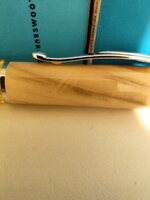Hello again,
I have a repeating problem in several of my pens: There are small scratches on them. Hope you can see it in the picture attached.
Also, the CA finish seems to be of different thicknesses on the same pen. Some parts are "glassy" and shiny, while other still feel "woody", with rougher surface and duller look.
maybe my sanding isn't sufficient enough? Or maybe I don't apply enough CA? Any suggestions on the causes and possible solutions are welcome. Thanks!
I have a repeating problem in several of my pens: There are small scratches on them. Hope you can see it in the picture attached.
Also, the CA finish seems to be of different thicknesses on the same pen. Some parts are "glassy" and shiny, while other still feel "woody", with rougher surface and duller look.
maybe my sanding isn't sufficient enough? Or maybe I don't apply enough CA? Any suggestions on the causes and possible solutions are welcome. Thanks!

